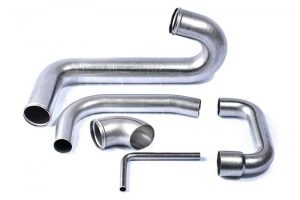“She told me they can’t bend those tubes and to call you.”
“I’m sorry, we don’t do that kind of work, but talk to Detroit Tube.”
“Everybody I talk to says they can’t do it, but you all say you bend metal tubes. What’s up with that?”
What’s up is that there are different ways to bend a tube, and each way makes sense for some applications, but not for others. All tube fabricators have their specialties, which means we have machines and dies that do some kinds of work easily and can’t do other work without a huge investment (huge).
Rotary bending is the bread and butter of Detroit Tube Products’ bending process. In fact, this process is what we use for mandrel bends. In order to do rotary drawing, you need to select the proper bend, wiper, pressure, and clamp die to get the type of bend you desire. All of these factors allow for production-run quantities of high-quality products. After you have gathered everything that you need, you insert the mandrel and allow the rotary machine to do its job. In the bender, the combination of the rotary and pressure manipulates and molds the tube into your desired shape.

At Detroit Tube Products, we focus on mandrel bending of relatively thin-walled metal, on a tight radius. It’s a process that puts support inside the tube (the mandrel or arbor) while the machine pulls the tube around a die that’s shaped like the bend we want to create. Without that mandrel, the tube will tend to collapse and lose its original cross-section (round or rectangular, for example). A heavier-walled tube or pipe doesn’t need so much support and can often be “empty-bent” without a mandrel and stay reasonably round in cross-section. Even a mandrel-bent tube will not be perfectly round throughout the bend area, depending on how severe the bend is.
We stock and bend a lot of 304 stainless and do 316 stainless mandrel bends. Others are less common and we may not stock but please REQUEST A QUOTE and we’ll most likely surprise you!
There are different styles of mandrel, some of them are solid rods, others with linked balls attached to the end. The balls enable more difficult bends. Ask our friend Google for “bend tooling” and you’ll have a feast of images.
Outside of mandrel bending, some people use the empty bending process. However, Detroit Tube Products does not use empty bending. This is because the entire process involves bending a tube with internal support like mandrel bends. This leads to faults in the tube such as containment and dirt pushed into the bend. In addition, these tubes often have wrinkles that can lead to rust. This makes these empty bends impractical for producing high-quality tubing products. However, you never have to worry about these issues with Detroit Tube Products.
There are plenty of applications where you don’t need that shape to be maintained: a muffler shop will bend a tube as a replacement with wrinkled, caved-in bends, and it’s perfectly useful for getting those exhaust gases where they need to go. Who cares how it looks? It’s under the car! Now, stainless steel tube bending for classic cars might be a different story. Furniture often has a tubular frame. Look at a stacking tubular chair, a hand cart, or a school desk, and you’ll see the bends “dented in.” They’re often bent in a press operation; they look uniform, stack and assemble well, and are relatively inexpensive to produce.
It all looks like tube bending, but it’s all different kinds of bending. When a customer contacts us to make a part, and it’s that school desk or the muffler, we can’t always help. We try our best to steer them to the tube fabricator who can do it well, for a reasonable price. And the same thing happens when our phone rings and the voice says, “She told me they can’t bend those tubes and to call you.”